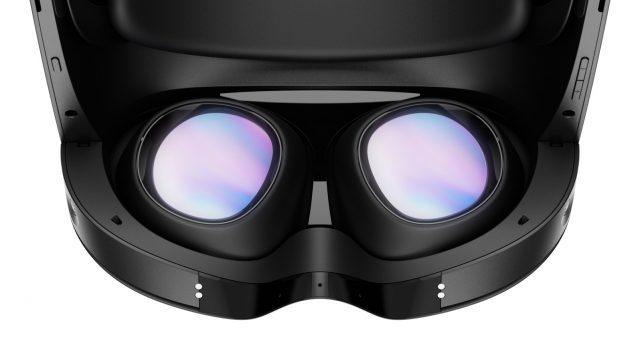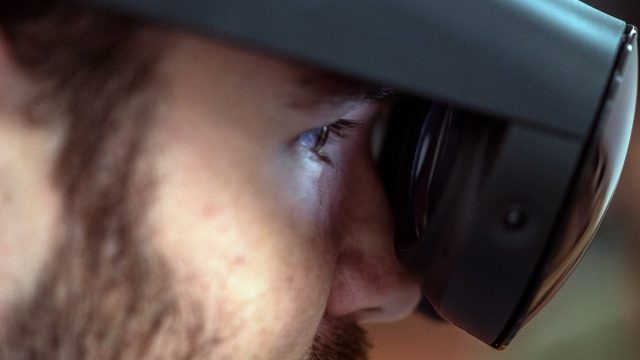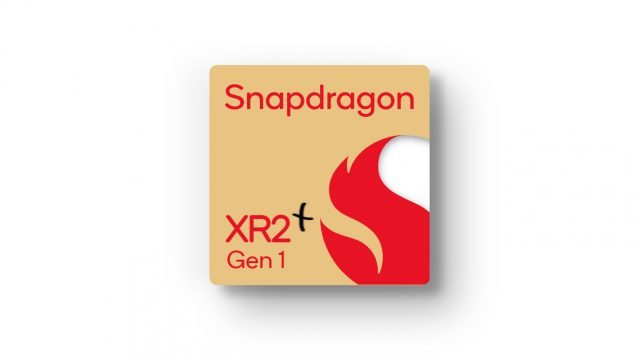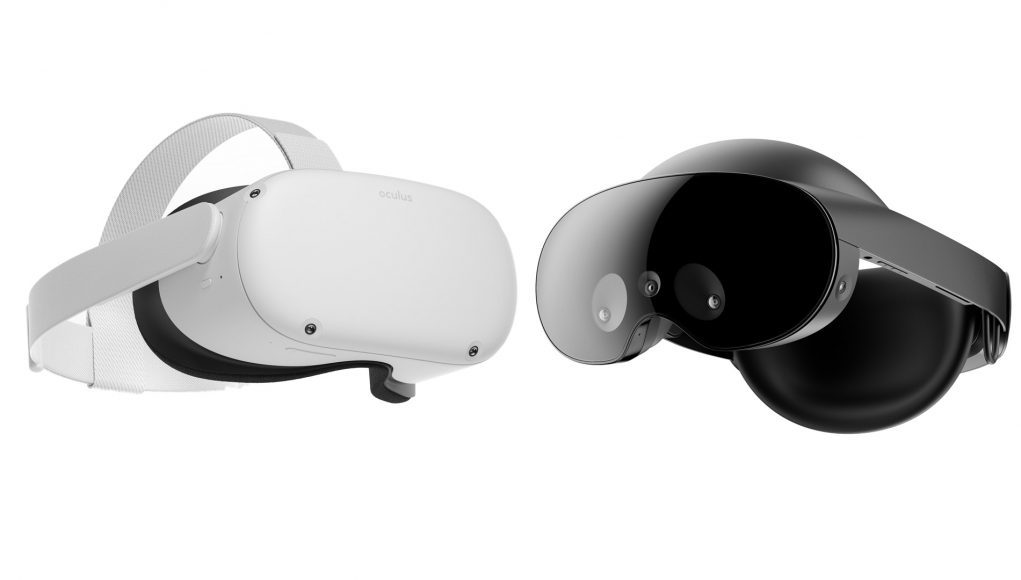Quest Pro has finally been revealed, and while it’s a much more expensive headset, inevitably people are interested in knowing how it compares to Meta’s next best headset, Quest 2. So here we’re going to look at Quest Pro vs Quest 2 specs side-by-side and break down what they really mean in detail.
There’s so much about XR headsets that is difficult to communicate from paper specs alone. So similar to my PSVR vs. PSVR 2 spec comparison here we’ll look at the numbers and I’ll use my recent experiences with the headset to explain more about what they do or don’t mean.
Quest Pro vs. Quest 2 Specs |
||
| Quest Pro | Quest 2 | |
| Resolution | 1800 × 1920 (3.5MP) per-eye, LCD (2x) | 1,832 × 1,920 (3.5MP) per-eye, LCD (1x) |
| Refresh Rate | 72Hz, 90Hz | 60Hz, 72Hz, 80Hz, 90Hz, 120Hz |
| Optics | Pancake non-Fresnel | Single element Fresnel |
| Field-of-view (claimed) | 106ºH × 96ºV | 96ºH × 96ºV |
| Optical Adjustments | Continuous IPD, continuous eye-relief | Stepped IPD, stepped eye-relief (via included spacer) |
| IPD Adjustment Range | 55–75mm | 58mm, 63mm, 68mm |
| Processor | Snapdragon XR2+ | Snapdragon XR2 |
| RAM | 12GB | 6GB |
| Storage | 256GB | 64GB, 128GB, 256GB |
| Connectors | USB-C | USB-C |
| Weight | 722g | 503g |
| Battery Life | 1–2 hours | 2–3 hours |
| Headset Tracking | Inside-out (no external beacons) | Inside-out (no external beacons) |
| Controller Tracking | Inside-out (headset line-of-sight not needed) | Headset-tracked (headset line-of-sight needed) |
| Expression Tracking | Yes (eyes, face) | none |
| On-board cameras | 5x external, 5x internal | 4x external |
| Input | Touch Pro controllers (rechargeable), hand-tracking, voice | Touch v3 (AA battery 1x), hand-tracking, voice |
| Audio | In-headstrap speakers, dual 3.5mm aux output | In-headstrap speakers, 3.5mm aux output |
| Microphone | Yes | Yes |
| Pass-through view | Yes (color) | Yes (B&W) |
| MSRP | $1,500 | $400 (128GB), $500 (256GB) |
So then, let’s talk about all of this.
Display & Optics
 This is one part of the spec sheet that’s actually pretty straightforward. With nearly the same resolution between Quest Pro and Quest 2, there’s just not going to be a real jump in resolving power between them. That said, Meta claims Quest Pro should look at least a bit sharper thanks to the optics.
This is one part of the spec sheet that’s actually pretty straightforward. With nearly the same resolution between Quest Pro and Quest 2, there’s just not going to be a real jump in resolving power between them. That said, Meta claims Quest Pro should look at least a bit sharper thanks to the optics.
The big deal with the new pancake optics in Quest Pro is that they’ve allowed the headset to shrink so it doesn’t feel quite as much like a box on your face. But Meta also says they are clearer, offering a 25% increase in sharpness at the center, and a 50% increase in the peripheral region.
That should mean the Quest Pro has a much better ‘sweet spot’ (the variance in clarity from one edge of the lens to other). However, it’s not apparent to me yet if these supposed increases in sharpness are specific to just the optics or if they include Quest Pro’s display as well—after all, if your resolving power is fundamentally limited by the number of pixels on the display, increasing the clarity of the lens won’t make any difference (I’ve been attempting to clarify this with Meta).
Granted, we know that the periphery of Quest 2’s lens is definitely limited by the lens rather than the display, so any increase there is sure to be an improvement in the overall sweet spot of the lens, especially if it’s really by 50%!
Regarding the refresh rate of Quest Pro and Quest 2… while the latter originally shipped with a 72Hz refresh rate, it can now run up to 120Hz. Quest Pro on the other hand tops out at 90Hz, and sources tell me it’s unlikely that it will increase after launch.
90Hz is largely considered the industry standard for a ‘good’ refresh rate on a VR headset, whereas anything higher has proven to be a nice-to-have but not quite essential feature. On Quest 2 only a small number of apps actually run at 120Hz. I’d bet the majority actually target 72Hz.
Optical Adjustments

Here Quest Pro gets some upgrades that I’m happy to see. While both headsets technically have a physical IPD adjustment and eye-relief adjustment, Quest 2 is somewhat hampered in this regard because the lenses can only be placed in three discrete IPD positions (58mm, 63mm, 68mm) and the eye-relief only has two positions. Neither of these adjustments can be easily made while wearing the headset itself.
Quest Pro on the other hand gains a continuous adjustment for both IPD (55–75mm) and eye-relief. And both adjustments are made with dials on the headset, making it easier for anyone to find the best lens position with less fiddling.
And one small but meaningful bonus on Quest Pro comes from its eye-tracking sensors… the headset will automatically measure the distance between the user’s eyes and tell them to position the lenses in the correct place. This is great because most people don’t actually know their IPD value, despite it being pretty important to XR devices, nor are most people particularly good at finding the right IPD position by visual inference.
Processor & RAM
 Qualcomm’s Snapdragon XR2 is the industry-standard chip for immersive XR headsets, and it has faithfully powered Quest 2 since the headset’s launch two years ago. But for Quest Pro, and all of its extra sensors, Meta needed more power. Instead of waiting for the next-gen XR2 chip, the company worked with Qualcomm on an interim solution which it calls Snapdragon XR2+.
Qualcomm’s Snapdragon XR2 is the industry-standard chip for immersive XR headsets, and it has faithfully powered Quest 2 since the headset’s launch two years ago. But for Quest Pro, and all of its extra sensors, Meta needed more power. Instead of waiting for the next-gen XR2 chip, the company worked with Qualcomm on an interim solution which it calls Snapdragon XR2+.
My understanding is that XR2+ is—transistor for transistor—literally the same chip as XR2 but backed up by twice the RAM (12GB) and a better cooling solution which allows it to run at higher speeds without overheating. Anyone who has ever overclocked their PC knows just how much heat is a limiting factor in processor performance; Meta’s claim that Quest Pro is getting some 50% more power out of the same chip is not unreasonable.
The big question on my mind is how much of that additional power translates to a headset that can run existing content at higher fidelity as opposed to how much of the extra power is reserved for the headset’s system-level functions. I would guess the majority of the extra power is going to the latter—after all, Quest Pro not only has higher resolution sensors, it has six additional sensors compared to Quest 2. All of that extra incoming data needs to be processed with as little latency as possible.
Assuming that’s the case, existing Quest 2 games probably won’t run any better on Quest Pro, while the benefits in processing power will come in the form of new apps that take advantage of system-level capabilities like improved passthrough and face-tracking.
I’ve asked Meta and third-party developers for more info on this front. Specifically I’m interested to know if an app that doesn’t need face-tracking can tap into the cycles that would have otherwise been reserved for that feature.
Field-of-view

This is another place where the specs as we see them are fairly clear: there isn’t a particularly obvious difference to me in the field-of-view between the two headsets.
However, a nice little bonus from the new continuous eye-relief adjustment on Quest Pro is that everyone will be able to move the lenses as close to their eyes as they are comfortable with. With varying facial topography, people can experience fairly different fields-of-view when the lens position is static. The ability to move the lenses forward and back means more people will be able to experience Quest Pro’s maximum field of view than if the lenses couldn’t move.
Another note on field-of-view is that Quest Pro is designed with an open peripheral view (compared to Quest 2 which blocks as much of the outside world as possible). This is intentional to make the headset’s passthrough mode feel more natural (since the real world in your periphery matches up with the passthrough view in the center of your vision.
Thoughtfully, Quest Pro also ships with ‘light blockers’ which magnetically attach to hide much of the outside peripheral view. An optional ‘full light blocker’ accessory goes even further and provides a more complete face-gasket for blocking out as much of the outside world as possible.
In the future it would be nice to see some kind of dynamic solution to opening or closing the peripheral field-of-view to the real world, but in any case, Quest Pro gets good marks for a high level of flexibility in this regard.







